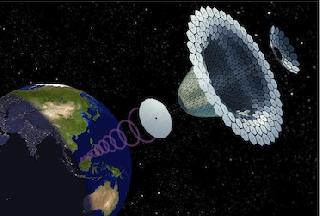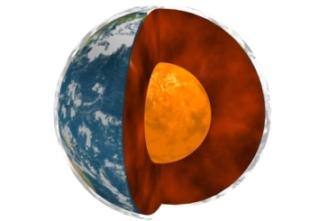
SPS-ALPHA (Solar Power Satellite via Arbitrarily Large Phased Array) concept for space solar power: reflectors concentrate sunlight onto module array. Satellite beams power to receiver from geosynchronous orbit. Image: John C. Mankins/NRL
WASHINGTON (PTI): Months after former Indian president Dr. APJ Abdul Kalam made a presentation of his vision to transport solar power from space to Earth, American scientists working at the Pentagon have developed the path-breaking technology to realise his dream into a reality.
Dr Paul Jaffe, a spacecraft engineer at the Naval Research Laboratory (NRL) of the US Department of Defence, has built and tested a module to capture and transmit solar power, the concept unveiled by Dr. Kalam in his presentation last May at the 32nd International Space Development Conference and Acceptance speech on receiving the prestigious Wernher Von Braun Memorial Award.
In a statement, Jaffe admitted that the idea of an orbiting solar array which would beam energy to the planet seemed "kind of crazy". But, like most novel ideas, he says, "Hard to tell if it's nuts until you've actually tried."
"What if you could capture solar power in space, then send it down to Earth? What if you could launch the hundreds of modules for such a satellite, then use robots to assemble the entire array in space? You could power a military installation, a city - even on a cloudy day, even at night," the NRL said in a statement, adding its brightest and most daring minds in satellites, space robotics and radiofrequency are building the technologies that could lead to such an achievement.
According to NRL, Jeff has developed the sandwich module: with a patent-pending "step" variation.
In the designs of the two prototypes that he has developed, one side receives solar energy with a photovoltaic panel, electronics in the middle convert that direct current to a radiofrequency, and the other side has an antenna to beam power away.
Jaffe sometimes gets asked about the efficiency of such a system, but the most important metric is the power cost per pound. "Launching mass into space is very expensive," says Jaffe, so finding a way to keep the components light is an essential part of his design. He can just cradle one module in his forearms.
The NRL said Jaffe's sandwich module is four times more efficient than anything done previously.
He also has a "novel approach to solving the thermal problem, using the 'step' module."
The step module design, now in the patent process, opens up the sandwich to look more like a zig-zag. This allows heat to radiate more efficiently, so the module can receive greater concentrations of sunlight without overheating.
In his presentation last year, Dr. Abdul Kalam had argued that the space solar power is not only safe and globally available, but can also be safely shared with all countries on this planet without proliferation concerns.
"It is steady & assured, for SSP is a continuous, rather than intermittent, power source. It is not subject to the weather, the seasons, or the day-night cycle. It needs no fundamental breakthroughs in either physics or engineering," Dr. Kalam said last May in California.
According to the International Academy of Astronautics, space solar power could be viable within the next 30 years.
In June last year, Dr. Kalam and America's National Space Society (NSS) announced to forge an international organisation involving US and India to develop space solar power.
"Time has arrived for us to together attempt to give a direction and momentum to this movement to realize space solar power and its enabling technologies through international collaboration that can help rebuild our environmentally vulnerable planet," said a joint statement issued by Dr. Kalam and Mark Hopkins, executive committee chairman of the National Space Society.
 Next Article
Next Article












The Indian Air Force, in its flight trials evaluation report submitted before the Defence Ministry l..
view articleAn insight into the Medium Multi-Role Combat Aircraft competition...
view articleSky enthusiasts can now spot the International Space Station (ISS) commanded by Indian-American astr..
view article